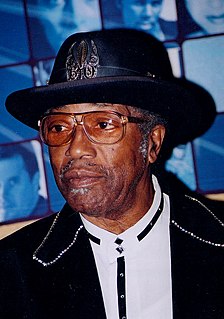
Ellas McDaniel, known as Bo Diddley, was an American singer, guitarist, songwriter and music producer who played a key role in the transition from the blues to rock and roll. He influenced many artists, including Buddy Holly, Elvis Presley, the Beatles, the Rolling Stones, the Animals, and the Clash.
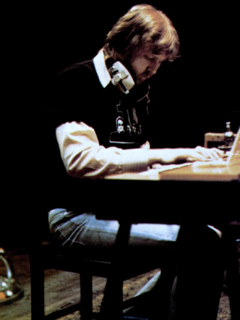
Harry Edward Nilsson III, known professionally as Nilsson, was an American singer-songwriter who achieved the peak of his commercial success in the early 1970s. His work is characterized by pioneering vocal overdub experiments, returns to the Great American Songbook, and fusions of Caribbean sounds. A tenor with a 3+1⁄2 octave range, Nilsson was one of the few major pop-rock recording artists to achieve significant commercial success without ever performing major public concerts or undertaking regular tours. The craft of his songs and the defiant attitude he projected remain touchstones for later generations of indie rock musicians.
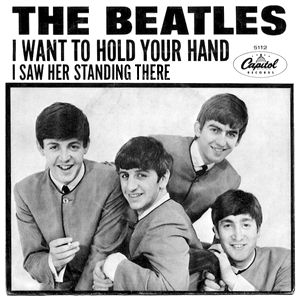
"I Want to Hold Your Hand" is a song by the English rock band the Beatles. Written by John Lennon and Paul McCartney, and recorded on 17 October 1963, it was the first Beatles record to be made using four-track equipment.
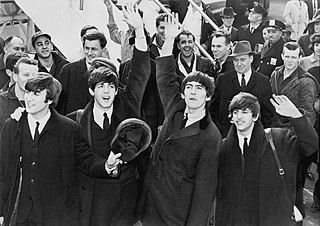
Beatlemania was the fanaticism surrounding the English rock band the Beatles in the 1960s. The group's popularity grew in the United Kingdom throughout 1963, propelled by the singles "Please Please Me", "From Me to You" and "She Loves You". By October, the press adopted the term "Beatlemania" to describe the scenes of adulation that attended the band's concert performances. From the start of 1964, their world tours were characterised by the same levels of hysteria and high-pitched screaming by female fans, both at concerts and during the group's travels. Commentators likened the intensity of this adulation to a religious fervour and to a female masturbation fantasy. Among the displays of deity-like worship, fans would approach the band in the belief that they possessed supernatural healing powers.

4 by the Beatles is an EP release by The Beatles. It is the third of three EPs released in the United States, the second from Capitol Records.

John S. Marascalco is an American songwriter most noted for the songs he wrote for Little Richard. He was born in Grenada, Mississippi.
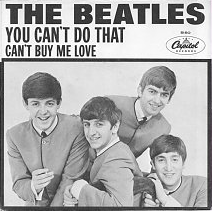
"You Can't Do That" is a song written by John Lennon and released by the English rock band the Beatles as the B-side of their sixth British single "Can't Buy Me Love". It was later released on their third UK album A Hard Day's Night (1964).
"I Wanna Be Your Man" is a Lennon–McCartney-penned song recorded and released as a single by the Rolling Stones, and then recorded by the Beatles. The song was primarily written by Paul McCartney, and finished by Lennon and McCartney in the corner of a room while Mick Jagger and Keith Richards were talking.

"I Wish You Would" is a song recorded by Chicago blues musician Billy Boy Arnold in 1955. It was developed while Arnold was performing with Bo Diddley and incorporates a Diddley-style rhythm. Called "a timeless Chicago blues classic", "I Wish You Would" is Arnold's best-known song and has been recorded by several artists, including the Yardbirds, who recorded it for their debut single in 1964.
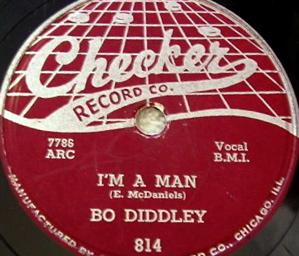
"I'm a Man" is a rhythm and blues song written and recorded by Bo Diddley in 1955. Inspired by an earlier blues song, it was one of his first hits. "I'm a Man" has been recorded by a variety of artists, including the Yardbirds, who adapted it in an upbeat rock style.

"Who Do You Love?" is a song written by American rock and roll pioneer Bo Diddley. Recorded in 1956, it is one of his most popular and enduring works. The song represents one of Bo Diddley's strongest lyrical efforts and uses a combination of hoodoo-type imagery and boasting. It is an upbeat rocker, but the original did not use the signature Bo Diddley beat rhythm.
"Too Much Monkey Business" is a song written and recorded by Chuck Berry, released by Chess Records in September 1956 as his fifth single. It was also released as the third track on his first solo LP, After School Session, in May 1957; and as an EP. The single reached number four on Billboard magazine's Most Played In Juke Boxes chart, number 11 on the Most Played by Jockeys chart and number seven on the Top Sellers in Stores chart in 1956.
"Hey! Bo Diddley" is Bo Diddley's eighth single released by Checker Records. The single's B side was "Mona".
"Road Runner" is a 12-bar blues song performed by American rock and roll performer Bo Diddley, originally released as a single by Checker Records in January 1960, and later released on the LP record Bo Diddley in the Spotlight. The song reached #20 on Billboard magazine's Hot R&B Sides chart, and #75 on the Hot 100. The song has since been recorded by many artists.

The Beatles experienced huge popularity on the British record charts in early 1963, but record companies in the United States did not immediately follow up with releases of their own, and the Beatles' commercial success in the US continued to be hampered by other obstacles, including issues with royalties and public derision toward the "Beatle haircut".

"You Can't Judge a Book by the Cover" is a 1962 song by rock and roll pioneer Bo Diddley. Written by Willie Dixon, the song was one of Diddley's last record chart hits. Unlike many of his well-known songs, "You Can't Judge a Book by the Cover" does not rely on the Bo Diddley beat. A variety of rock and other performers have recorded renditions of the song.

For the Love of Harry: Everybody Sings Nilsson, released on 9 May 1995 by Musicmasters, is a tribute album to Harry Nilsson released after his death. Proceeds went to the Coalition to Stop Gun Violence.

The Fest for Beatles Fans is a twice-annual, three-day festival that honors the lasting legacy of the Beatles. The festival takes place in the New York metropolitan area, ordinarily in March or April, and in Chicago, Illinois, each August. Running Friday through Sunday, the Fest features special guests, live concerts, exhibits, art contests, a Beatles marketplace, a sound-alike contest, a Battle of the Beatles Bands, and more.
"This Could Be the Night" is a song recorded by the American band Modern Folk Quartet (MFQ) in late 1965 or early 1966. The lyrics describe a couple on the verge of conquering their inhibitions. Written in tribute to Beach Boys leader Brian Wilson, the song is one of three that are credited jointly to Harry Nilsson and Phil Spector, although Nilsson submitted that he was the sole writer on a 1966 copyright form.

"You're Breakin' My Heart" is a song written by Harry Nilsson, appearing on his 1972 album Son of Schmilsson. It is notorious for the opening line, "You're breakin' my heart / You're tearin' it apart / So fuck you".
















